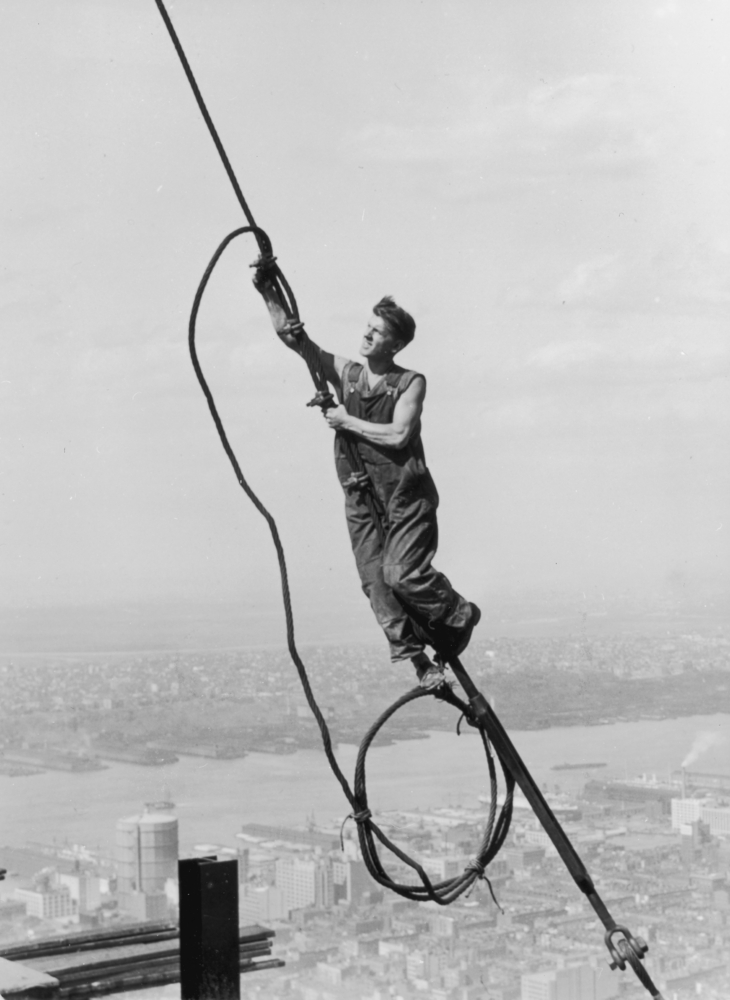Much has been written recently about the conviction of New York Assembly Speaker Sheldon Silver, and New York’s opaque “method” of distributing money. Short version of the story: there is a ginormous amount of discretion that goes to New York’s legendary “three men in a room” when it comes to distributing cash from various slush government funds.
This leads to the not insubstantial problem that public money may be traded for private favors or business. Our former Senate leader Dean Skelos is also on trial for corruption, and for all I know, Gov. Andrew Cuomo could be next.
But the money and favors sloshing around Albany are not, by any means, the only places where opaque business might be done.
It also exists in insurance company arguments to eviscerate a part of our Labor Law known as the Scaffold Law, which protects people working at heights if the contractor fails to follow required safety rules, by making the contractors strictly liable.
These two concepts are tied up together in a Cato Institute article written by Walter Olson, he also of Overlawyered fame. I won’t take issue with his conclusions on trial lawyers, but rather, upon one of the “facts” that his opinion is based upon. Notice those scare quotes around “facts?” That’s where we’re headed.
In condemning trial lawyers, Olson writes:
I got interested in Silver originally because of his distinctive role as protector of New York’s trial lawyers and their various schemes for using liability law to keep up a steady flow of redistribution through the court system.
But what factual support does he cite? It apparently comes, if you follow his links, to a 2012 column in the Daily News by Bill Hammond regarding the scaffold law, and these comments from a defense lawyer and contractor (with the bolding provided by me):
“The problem with the law is it’s so expansive that virtually every accident on the job site is going to result in civil liability,” said defense attorney William Greagan of Goldberg Segalla in Albany. “I tell my contractors, if an ambulance comes to your site, you’re going to get sued.”
The result, according to Michael Elmendorf of the General Contractors Association, is that New York contractors have to pay an extra 30% for their liability insurance.
For the $5 billion Tappan Zee project, that senseless cost equates to a whopping $100 million.
That claim of 30%, however, is wholly unsupported. In other words, Olson’s theory is supported by an unsupported anecdote, and not empirical evidence.
So here’s the funky part, and the reason that I write today. The actual data that is needed to reach a conclusion as to how much, if any, additional cost is caused by the scaffold law is kept secret by the insurance industry. The insurers simply lump the scaffold law lawsuits in with all the others: motor vehicle injuries, trips/slips and falls, electrical injuries, chemical injuries, and food poisoning from the company food truck.
When the insurance companies, therefore, claim that premiums are going up due to scaffold law lawsuits, the only proper response is: Show me the claims data. And they won’t. They refuse.
The conclusion of a 30% hike based on the scaffold law is nothing more than a wild guess. It has just as much validity as me typing up 2%.
In a Twitter discussion over the weekend, Olson defends his argument by writing that”Customers, not just carriers, can measure how much more it costs to insure certain kinds of job in New York.” But this is error. The customer doesn’t know, because the customer can’t know, because the data is kept secret.
Hammond does the same thing, citing to a 2013 Crains’ article by Daniel Geiger on rising school construction insurance costs. But that article suffers from the same problem: opinions are given without actually looking at the data to determine the reason for the costs. There is no way to determine how many claims, or payments, are due to height-related injuries where the contractor failed to provide safety equipment.
Conclusions based on undocumented anecdotes are worthless, for as we all learned in grade school, “garbage in, garbage out.”
But wait, there is a remedy for this! I’m not going to leave you hanging.
And it sits in the form of legislation proposed by Assemblyman Francisco Moya. This legislation calls for transparency by the insurance industry, so that it opens its books so that the claims can be examined. For only then can an intelligent discussion even begin. Moya writes:
“The Sunshine Bill will shed much needed light on insurance industry pricing and practices. For years the industry has claimed that New York’s strong workplace safety regulations drive up insurance rates, but have never provided any actual proof.”
 If I showed up for a trial and asked the jury to just “trust me” they would toss me out on my ear. As they should. I can only help my clients by presenting evidence.
If I showed up for a trial and asked the jury to just “trust me” they would toss me out on my ear. As they should. I can only help my clients by presenting evidence.
And if the insurance industry claims that hikes are based on the scaffold law — but it steadfastly refuses to support that case with actual evidence — it too should be tossed out on its ear.
Unsupported claims shouldn’t be used by people who care about public policy.
So here’s the magic question: If you were a legislator, or advocate for policy change, wouldn’t you want to know what the data said before trying to fashion a solution?
As Louis Brandeis once said, “Sunlight is said to be the best of disinfectants.”

This is the standard cynical response by the insurance, medical, etc. industries to every piece of legislation to protect consumers in the State of New York. Every potential bill presented in the Assembly to give basic rights to aggrieved individuals faces this cost argument. For example, New York is one of the few states that does not have a date of discovery law regarding medical malpractice. Studies show that malpractice insurance do not increase in the states that have this law but despite the hard evidence the medical/insurance industries still claim that the malpractice rates will skyrocket and doctors will go out of business or leave NY to greener pastures. The industry does not dispute the merits of the bill but rather present a cost argument, an argument unsupported by any factual statistical data. They would rather just throw out self-serving numbers to support their position rather than actually having an established cost argument because they just do not have one. If they did then they would present studies showing same to oppose the scaffold, date of discovery laws, etc but to date, none are forthcoming. This is the real reason they are opposing any type of “sunshine” legislation rather than the business secrets/trademark infringement pretext they present to the general public. Until sunshine laws are enacted it will be difficult to have an intelligent discussion with their representatives when they’re only response is “because I said so.”
Pingback: Watching Danger in Real Time | New York Personal Injury Law Blog
Pingback: Liability roundup - Overlawyered
How do the customers know? Because of the price system. Every piece of liability has a price that in an efficient market is passed on to consumers. New York construction is abysmally expensive. One of these factors is likely liability rules like the Scaffolding Law, but others would know if there have been actual studies on this or whether simple comparisons can be made. The point is you do not necessarily have to have access to the claims data.
New York construction is abysmally expensive. One of these factors is likely liability rules like the Scaffolding Law, but others would know if there have been actual studies on this or whether simple comparisons can be made. The point is you do not necessarily have to have access to the claims data.
That is correct…you don’t have access to the claims data and therefore you are stuck taking guesses. How is a Legislator supposed to know which parts of the premium are due to scaffold law or other claims that might be made? It can’t be done.
You can’t even discuss the issue until you have the data.
“Every piece of liability has a price that in an efficient market is passed on to consumers.”
And if pigs could fly, reinforced umbrellas would be a growth industry.
– Jake
The scaffold laws protect those it covers from all the BS and false defenses, suborned by the defense lawyers that otherwise occur in litigation involving ordinary negligence, that enable the insurance companies to weasel their way out of paying. It also partially guards against drawn out ligation. In other words, it ensures that those injured on the job are properly and timely compensated for their injuries, many of which are horrific and most of which were preventable.
Unfortunately, our workers’ compensation laws relieve the employer of liability for a worker’s injuries even if the employer deserves most of the blame, for example telling a worker to hold back an 800 lb. spool of wire descending a flight of stairs a with a rope wrapped around a pipe. There is an exception for specifically defined “grave injuries,” but those are few and far between.
If the owner of the building is held responsible, and can’t rely on defense counsel to weasel out of paying the injured worker, that owner will purchase insurance to cover the risk. Additionally, the owner may have an incentive to ensure that the work on its building involving elevation-related risk is done in a safe manner.
It is my opinion that the cost of compensating injured workers from elevation related injuries has gone down because of all the added safety devices in place from the Scaffold Law and the lower incidence of accidents as a result. Now the insurance companies want to repeal the law to force the injured parties to exhaustively litigate their claims, and possibly lose, thereby leaving the injured workers with no recourse.
So why would a 30 % extra cost be a bad thing, again?
A 30 % extra cost to the insurers sounds like an incentive for employers and insurers to work together to bring down exposure by bringing down accident rates.
Homeowners who install reinforced doors and alarms get a cut off their household goods insurance rate compared to those who do not. There is no reason, other than laziness on part of the insurance salesmen, that the same mechanic cannot gainfully be applied to workplace liability insurance and personal protective equipment.
– Jake